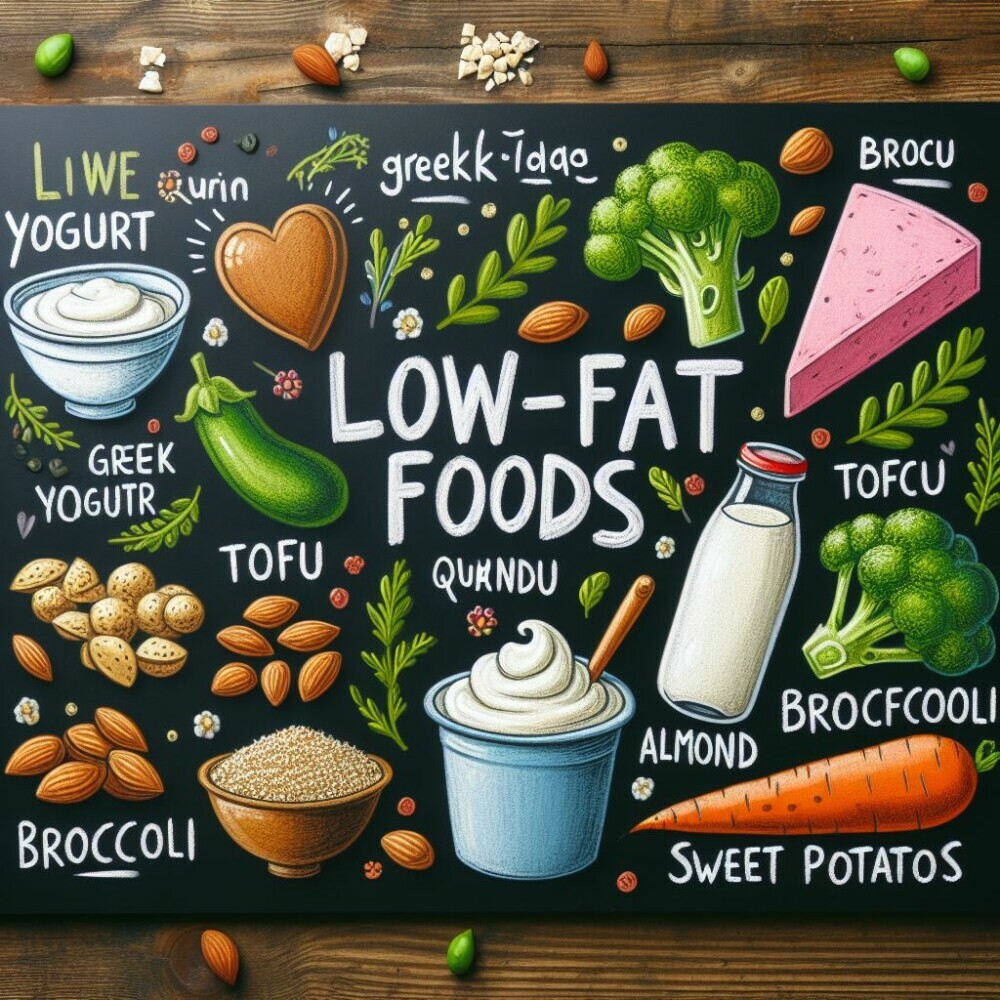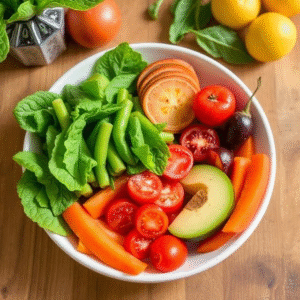
In today’s health-conscious world, having a low fat foods list at hand is the smart move. And incorporating low-fat foods into a balanced diet is even smarter and crucial for maintaining overall wellness.
By reducing your fat intake, you can manage your weight more effectively and lower the risk of various health conditions. In this ultimate guide, we’re on a mission to discover delicious, waistline-friendly options that will leave you feeling satisfied and energized. A low fat foods list for life.
Low Fat Foods List – Your Ultimate Guide To Healthy Eating
The Low Fat Basics
Understanding Fat Types: When it comes to fats, not all are created equal. Saturated fats, often found in butter, fatty meats, and full-fat dairy products, can contribute to health issues when consumed in excess.
On the other hand, unsaturated fats, found in foods like avocados, nuts, and olive oil, are considered beneficial for heart health and overall well-being. It’s essential to keep saturated fats in check while embracing the unsaturated fats as allies in your quest for a healthier lifestyle.

Your Low Fat Foods Daily Fat Intake
To maintain a healthy diet, it’s recommended to consume fats in moderation, accounting for about 20-35% of your total daily calories. By being mindful of your fat intake and opting for low-fat alternatives, you can achieve a balanced diet that supports your long-term health goals. This range allows for flexibility based on your specific dietary needs and preferences.
For example, if you consume 2000 calories per day, your fat intake would ideally fall within the range of 44 to 78 grams of fat per day. It’s important to focus on consuming mostly unsaturated fats from sources like avocados, nuts, seeds, and olive oil, while limiting saturated and trans fats found in processed foods, fried foods, and high-fat dairy products.
Remember that dietary fat is essential for various bodily functions, including hormone production, nutrient absorption, and energy storage. However, moderation and balance are key when it comes to fat consumption to support overall health and well-being. It’s always a good idea to consult with a healthcare professional or registered dietitian for personalized guidance on your dietary needs.
The Low Fat Pantry
Stocking Up for Success: When it comes to building a low-fat pantry, it’s all about choosing nutrient-rich foods that are low in fat but high in flavour. Here are some essentials to have on hand:
Lean Proteins: Incorporate chicken breast, turkey, and fish such as salmon, tuna, or cod for protein-packed meals without the added fat.
Dairy Delights: Opt for Greek yogurt, skim milk, and cottage cheese as creamy, calcium-rich options with minimal fat content.
Plant Power: Include legumes like beans, lentils, and chickpeas, as well as quinoa and spinach, for fibre and protein without the excess fat.
Now, the low fat foods list doesn’t end there, we all have different food requirements so here’s a list that offers more choice:
Low Fat Foods List – Fruits
- Berries (strawberries, blueberries, raspberries)
- Apples
- Oranges
- Bananas
- Kiwi
- Grapefruit
- Mangoes
- Papaya
- Peaches
- Pears
- Plums
- Grapes
- Watermelon
- Cantaloupe
Vegetables
- Leafy greens (spinach, kale, lettuce, Swiss chard)
- Cruciferous vegetables (broccoli, cauliflower, Brussels sprouts)
- Tomatoes
- Bell peppers
- Carrots
- Cucumbers
- Zucchini
- Mushrooms
- Asparagus
- Green beans
- Peas
- Sweet potatoes
- Squash (butternut, acorn, spaghetti)
Whole Grains
- Quinoa
- Brown rice
- Oats
- Barley
- Bulgur
- Whole wheat bread
- Whole wheat pasta
- Buckwheat
- Millet
- Faro

Low Fat Foods List – Lean Proteins
- Skinless poultry (chicken breast, turkey breast)
- Fish (salmon, tuna, cod, tilapia)
- Shellfish (shrimp, crab, lobster)
- Lean cuts of beef or pork (loin, tenderloin)
- Tofu
- Tempeh
- Legumes (beans, lentils, chickpeas)
Dairy and Dairy Alternatives
- Skim milk
- Greek yogurt (plain, non-fat)
- Cottage cheese (low-fat or fat-free)
- Reduced-fat cheese (mozzarella, feta)
- Unsweetened almond milk
- Soy milk, unsweetened
- Unsweetened coconut milk (beverage)
Nuts and Seeds (in moderation)
- Almonds
- Walnuts
- Pistachios
- Cashews
- Chia seeds
- Flaxseeds
- Pumpkin seeds
- Sunflower seeds
Healthy Fats (consume in moderation)
- Avocado
- Olive oil
- Canola oil
- Peanut butter (unsweetened)
- Almond butter (unsweetened)
- Sunflower oil
- Sesame oil
Incorporating these low-fat, nutrient-rich foods into your diet can help you maintain a balanced and healthy eating plan while providing essential vitamins, minerals, fibre, and antioxidants. Remember to focus on variety and portion control to ensure you’re meeting your nutritional needs while managing your fat intake effectively.
Low Fat Foods List – Low Fat Cooking Techniques
Flavour Without the Fat: Cooking low-fat meals doesn’t mean sacrificing flavour. By using the right techniques, you can enhance the taste of your dishes without adding extra fat. Try:
Grilling and Roasting: Lock in flavour without drowning your food in oil. Plus, those grill marks are not only delicious but also Instagram-worthy.
Herbs and Spices: Elevate your dishes with herbs like basil, oregano, and garlic, adding depth and complexity without the calories.
Here are some of the best cooking methods for reducing fat:
- Grilling: Grilling allows excess fat to drip away from the food, resulting in lower fat content. It’s a great way to cook lean proteins like chicken breast, fish, and vegetables while adding a delicious smoky flavour.
- Baking or Roasting: Baking or roasting foods in the oven with minimal added fat can help them cook evenly and develop a rich flavour without the need for frying or sautéing. Use a non-stick cooking spray or a small amount of oil to prevent sticking.
- Steaming: Steaming is a gentle cooking method that preserves nutrients and keeps food moist without adding any fat. It’s ideal for vegetables, seafood, and even proteins like chicken or tofu.
- Broiling: Broiling is similar to grilling but uses direct heat from above. It’s a quick and efficient way to cook foods like fish fillets, lean cuts of meat, and vegetables while allowing excess fat to drain away.
- Stir-Frying: Stir-frying involves cooking small pieces of food quickly in a hot pan with minimal oil. Use a non-stick skillet and a small amount of oil (such as olive oil or sesame oil) to sauté vegetables, lean proteins, and tofu for a flavourful and low-fat meal.
- Poaching: Poaching involves cooking food in simmering liquid, such as water, broth, or wine. It’s a gentle cooking method that helps retain moisture while adding flavour without the need for added fat. Poaching is often used for delicate proteins like fish and eggs.
- Air Frying: Air frying uses hot air to cook food quickly and evenly, resulting in crispy textures similar to deep frying but with significantly less fat. It’s a healthier alternative to deep frying and can be used to cook a wide variety of foods, including chicken wings, French fries, and vegetables.
By incorporating these cooking methods into your meal preparation, you can reduce the amount of fat in your diet while still enjoying delicious and flavourful dishes. Experiment with different techniques to find the ones that work best for your taste preferences and dietary goals.
Low Fat Snacking Strategies
Snacking can be a part of a healthy diet when done right. There are plenty of low-fat snacks that you can enjoy as part of a balanced diet. Here are some low fat foods ideas for low-fat snack options:
- Fresh Fruit: Fruits such as apples, oranges, berries, grapes, and melons are naturally low in fat and calories. They’re also packed with vitamins, minerals, and fibre, making them a nutritious choice for snacking.
- Vegetables: Raw vegetables like carrots, celery, cucumbers, bell peppers, and cherry tomatoes make excellent low-fat snacks. You can enjoy them plain or with a side of hummus or low-fat dip for added flavour.
- Air-Popped Popcorn: Popcorn that’s air-popped or lightly seasoned with herbs and spices can be a satisfying low-fat snack. Just be mindful of added butter or oil, as these can increase the fat content.
- Rice Cakes: Rice cakes are a crunchy, low-fat snack option that can be enjoyed plain or topped with nut butter, sliced fruit, or cottage cheese for extra flavour and protein.
- Greek Yogurt: Greek yogurt is a creamy, protein-rich snack that’s low in fat. Opt for plain, non-fat Greek yogurt and add your favourite toppings such as fresh fruit, nuts, or a drizzle of honey for sweetness.
- Cottage Cheese: Cottage cheese is a low-fat, high-protein snack that can be enjoyed on its own or paired with fruit, vegetables, or whole grain crackers for a satisfying snack.
- Edamame: Edamame, or steamed soybeans, are a nutritious snack option that’s rich in protein, fibre, and essential nutrients. Simply boil or steam edamame and sprinkle with a little sea salt for a tasty snack.
- Hummus: Hummus is a creamy dip made from chickpeas, tahini, lemon juice, and garlic. It’s naturally low in fat and can be enjoyed with raw vegetables, whole grain crackers, or pita bread for a satisfying snack.
- Smoothies: Homemade smoothies made with low-fat milk or yogurt, fresh or frozen fruit, and leafy greens are a delicious and nutritious snack option. You can customize your smoothie with your favourite ingredients for a tasty and low-fat treat.
- Low-Fat String Cheese: Low-fat string cheese is a convenient and portable snack option that’s rich in protein and calcium. Enjoy it on its own or paired with whole grain crackers for a satisfying snack.
Your Low Fat Foods List Guide
- Nuts and Seeds: Enjoy almonds and chia seeds for a crunchy, satisfying snack that’s heart-healthy and packed with essential nutrients.
- Fruit Frenzy: Indulge in nature’s sweets with apples, berries, and watermelon, which are not only low in fat but also bursting with flavour and antioxidants.

Low Fat Foods List – Dining Out and Navigating Food.
Eating out can present challenges when trying to maintain a low-fat diet, but there are several strategies you can use to make healthier choices while dining out, you can still make smart choices that align with your low-fat lifestyle. As a part of your low fat foods list you could:
- Plan Ahead: Look up the menu online before you go to the restaurant, if possible. This allows you to review your options and choose a dish that aligns with your low-fat goals.
- Choose Grilled, Steamed, or Broiled Options: Look for menu items that are grilled, steamed, or broiled rather than fried or sautéed. These cooking methods typically use less fat and result in lower-calorie dishes.
- Ask for Modifications: Don’t be afraid to ask for modifications to suit your dietary preferences. Requesting dressing on the side, opting for grilled instead of fried, or substituting vegetables for high-fat sides can help reduce the fat content of your meal.
- Be Mindful of Sauces and Condiments: Many sauces, dressings, and condiments are high in fat and calories. Ask for sauces and dressings on the side, and use them sparingly. Alternatively, choose dishes that are served with lighter sauces or ask if the restaurant offers low-fat or reduced-fat options.
- Watch Portion Sizes: Restaurant portions are often larger than what you would serve yourself at home. Consider sharing a dish with a friend or asking for a to-go box to take home half of your meal for later.
- Focus on Lean Proteins and Vegetables: Choose dishes that feature lean proteins such as grilled chicken, fish, or tofu, along with plenty of vegetables. These options are typically lower in fat and higher in nutrients compared to dishes that are heavy on cheese, cream, or fried ingredients.
- Skip the Extras: Avoid high-fat extras like bread baskets, appetizers, and desserts if you’re trying to keep your meal low in fat. Instead, focus on enjoying the main course and savouring the flavours’ of your meal.
- Stay Hydrated: Drinking water or other low-calorie beverages with your meal can help you feel full and satisfied without adding extra calories from sugary drinks or alcohol.
Your Low Fat Foods List For Life.
Salads Done Right: Opt for vinaigrettes instead of creamy dressings and add grilled chicken or shrimp for a protein boost.
Asian Adventures: Explore Asian cuisine with sushi rolls (hold the mayo) and steamed dumplings for flavourful, low-fat options.
By following these tips and being mindful of your choices, you can enjoy dining out while still sticking to your low-fat diet goals. Don’t be afraid to ask questions and advocate for your dietary needs when dining out—it’s your health, after all!
Conclusion To My Low Fat Foods List
In conclusion, incorporating a low fat foods list, and implementing it into your diet doesn’t have to be bland or restrictive. By making mindful choices and prioritizing nutrient-rich options, you can enjoy delicious meals while supporting your health and well-being.
Remember to experiment with flavour’s and ingredients, and don’t be afraid to get creative in the kitchen. With this ultimate guide to low-fat eating, you can embark on your journey to a healthier lifestyle with confidence and enthusiasm. Cheers to delicious, waistline-friendly noshing! Keep yourself and others around you healthy by sharing useful content. You could also leave a comment or any questions below.
Your Ultimate Training Guide.






